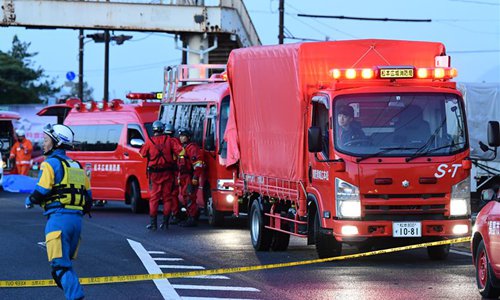HOME >> WORLD
Hagibis death toll hits 66, rescue work continues
Source:Reuters Published: 2019/10/15 19:23:40
The death toll in the worst typhoon to hit Japan for decades climbed to 66 on Tuesday as rescuers slogged through mud and debris in an increasingly grim search for the missing, and as thousands of homes remained without power or water.

Fifteen people remain missing nearly three days after Typhoon Hagibis smashed into central and eastern Japan, national broadcaster NHK said. More than 200 people were injured in the storm, whose name means "speed" in the Tagalog language.
The highest toll was in Fukushima prefecture north of Tokyo, where levees burst in at least 14 places along the Abukuma River, which meanders through a number of cities in the largely agricultural prefecture. At least 25 people died in Fukushima, including a mother and child who were caught in flood waters, NHK said. Another child of the woman remains missing.
Residents in Koriyama, one of Fukushima's larger cities, said they were taken by surprise by the flooding. Police were searching house-to-house to make sure nobody had been left behind or was in need of help.
"The river has never flooded like this before, and some houses have been completely swept away. I think it might be time to redraw hazard maps or reconsider evacuation plans," said Masaharu Ishizawa, a 26-year-old high school teacher who was cleaning up at his family home in Koriyama.
He said there are a lot of elderly in his area and many of them were taken in by relatives.
"We have never seen damage like this before, and maybe global warming and environmental change has something to do with it."

Policemen and firefighters participate in rescue and relief operations in Nagano Prefecture, Japan, Oct. 13, 2019. The bank of the Chikuma River in Nagano Prefecture collapsed and caused massive flooding in residential areas. Nagano Prefecture was one of the areas hit hard by Typhoon Hagibis in Japan. Photo:Xinhua
Fifteen people remain missing nearly three days after Typhoon Hagibis smashed into central and eastern Japan, national broadcaster NHK said. More than 200 people were injured in the storm, whose name means "speed" in the Tagalog language.
The highest toll was in Fukushima prefecture north of Tokyo, where levees burst in at least 14 places along the Abukuma River, which meanders through a number of cities in the largely agricultural prefecture. At least 25 people died in Fukushima, including a mother and child who were caught in flood waters, NHK said. Another child of the woman remains missing.
Residents in Koriyama, one of Fukushima's larger cities, said they were taken by surprise by the flooding. Police were searching house-to-house to make sure nobody had been left behind or was in need of help.
"The river has never flooded like this before, and some houses have been completely swept away. I think it might be time to redraw hazard maps or reconsider evacuation plans," said Masaharu Ishizawa, a 26-year-old high school teacher who was cleaning up at his family home in Koriyama.
He said there are a lot of elderly in his area and many of them were taken in by relatives.
"We have never seen damage like this before, and maybe global warming and environmental change has something to do with it."
Posted in: ASIA-PACIFIC